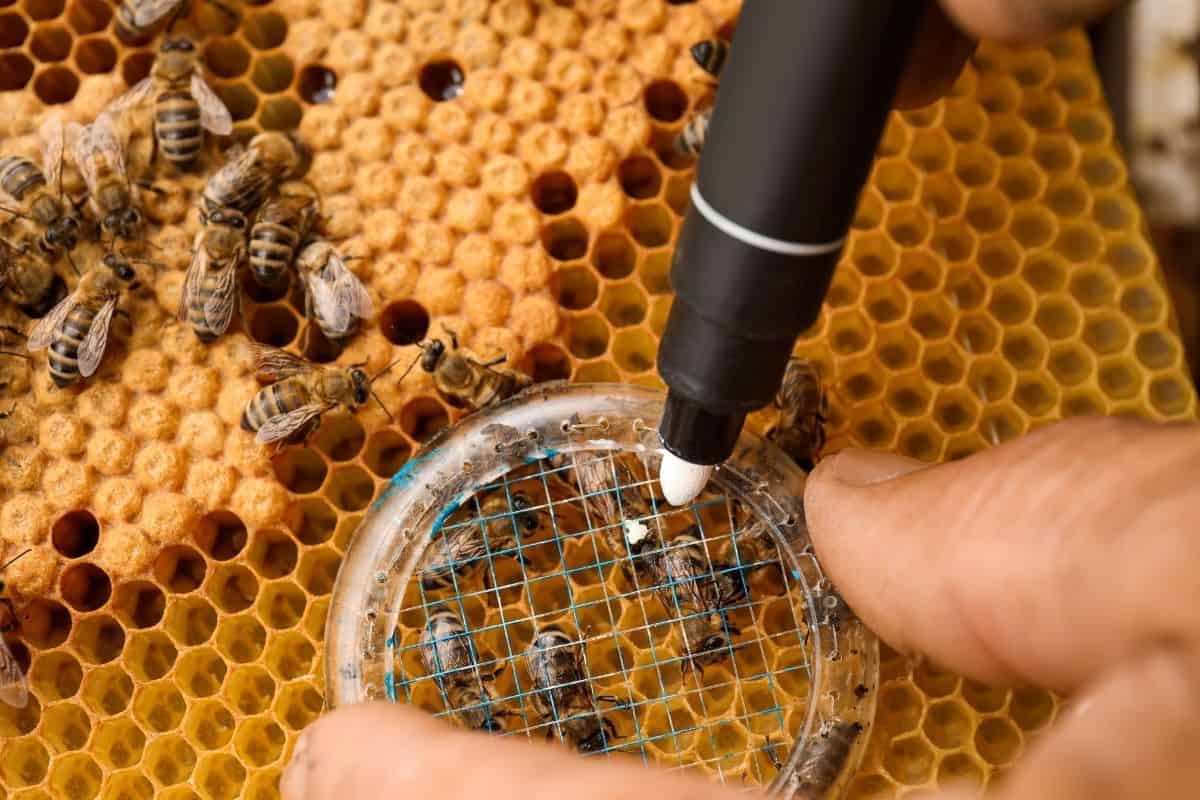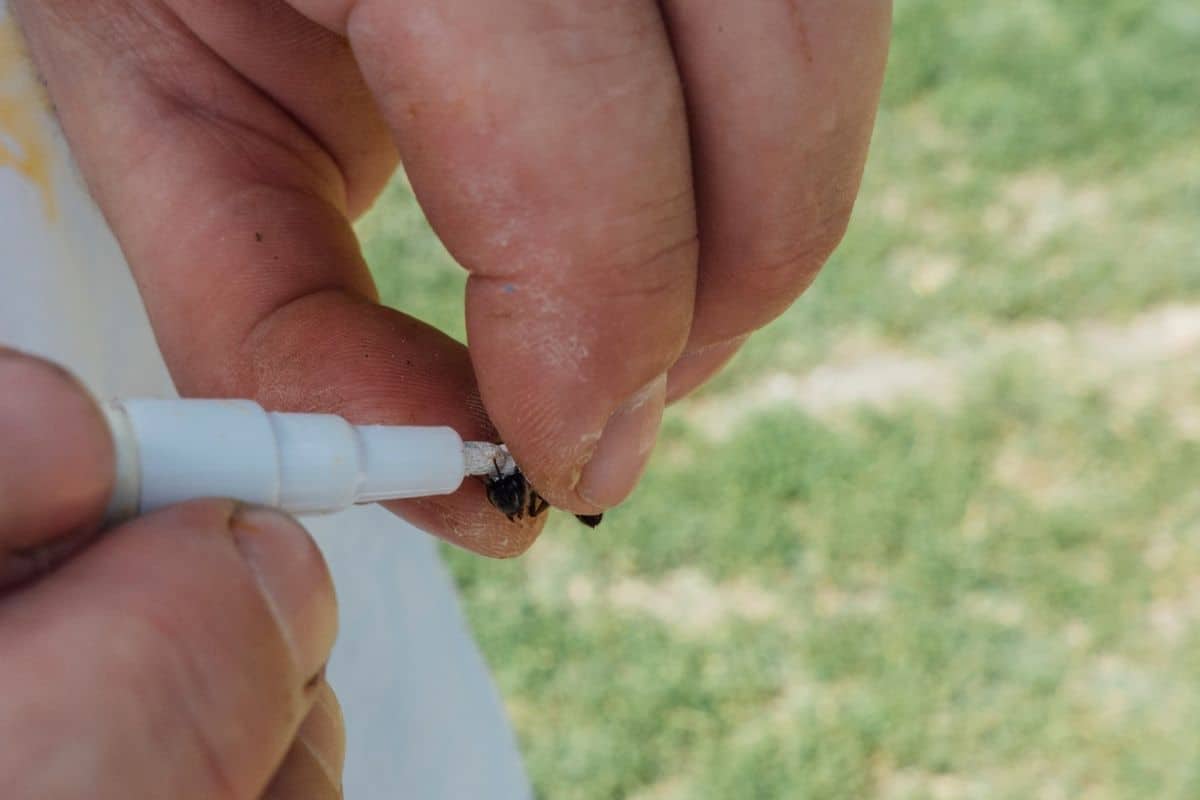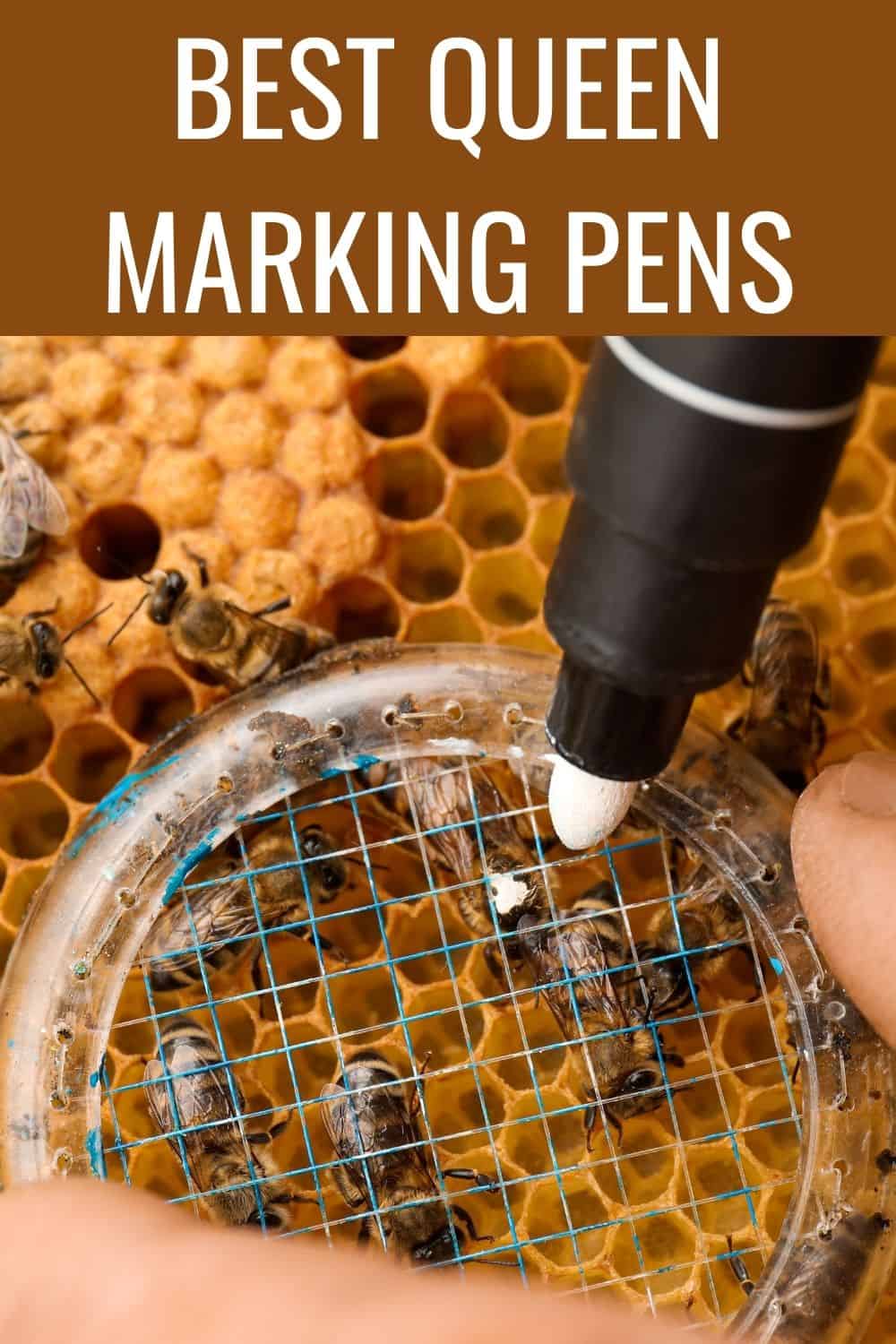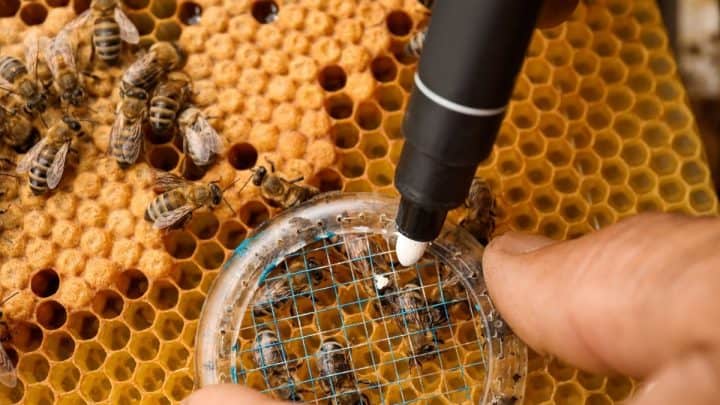If you are a new beekeeper, you may wonder why it is necessary to mark your queen bees, which we will explain and the best method to do this. The challenge with marking your queen is to use a method that will not harm the queen and one that will stay on the queen for a long time. Marking pens are one way to achieve this, but which are the best ones to use?
Queen marking pens are a quick and easy way to mark the queen bee in your hive for easy identification. POSCA water-based paint marking pens have become the go-to markers for beekeepers, but you have options of other brands and oil-based paints for a longer-lasting mark on the queen.

Queen marking for beekeepers is not a necessity, but as you expand the hobby, you will recognize the benefits of this practice. When that time comes to mark your queen, you will need to find a quick and easy method to mark your queen as safely as possible. Marking pens are the best way to achieve this, and we cover the ins and outs of this topic to help find the right pen for the job.
Why Do Beekeepers Mark Their Queen Bees
New beekeepers may not understand the importance of marking the colony queen, but the strategy has some important advantages for beekeeping.
There are 3 main reasons for marking the queen.
- Easy location. The queen is often difficult to spot when you open the hive, and she may even hide to escape detection. The beekeeper needs to locate the queen when working in the hive to ensure she is present and prevent accidentally killing the queen in the process.
- To keep track of the queen’s age. Marking the queen will allow the beekeeper to keep track of the age of the queen. This will allow the beekeeper to understand a colony’s production drop-off and know when a queen needs replacing.
- To know when a queen has been replaced. If you mark your queens and when you open a hive, you see a queen that is not marked, you know that the old queen has been replaced, which gives you an idea of what is going on in the colony. The original queen could have been usurped, swarmed off, been superseded by a younger queen, or died accidentally.
Marking the queen helps the beekeeper to better keep track of what is going on in the colony and promotes better management of the bees.
Marking the bees needs to be done systematically, which allows for easy record keeping and monitoring of the colony. There is an international queen marking protocol that you should follow to ensure that your marking method is the same as other beekeepers.
This promotes consistency in the beekeeping industry and allows beekeepers who are new to the activity to immediately understand what is going on when looking into a hive for the first time.
Follow the International Queen Bee Marking Standards
Beekeepers worldwide follow the same standard in marking queens, allowing beekeepers to work on different hives and have access to the same information.
Many queen producers will also use the same marking standard for their queens, so you know exactly how old she is and which year she was raised when you receive a new queen.
The international marking standard follows a five-color marking cycle, representing a five-year span. Queen bees do not live beyond 5-years which is why this timeframe was agreed as the standard.

| Color Indicator | Last Digit In The Year | |
| White | 1 or 6 | |
| Yellow | 2 or 7 | |
| Red | 3 or 8 | |
| Green | 4 or 9 | |
| Blue | 5 or 0 |
For example, the year 2021 queen should have a white mark, as will a queen raised in 2026. A queen raised in 2022 will be marked yellow, as will a queen raised in 2027.
What Should You Use To Mark Your Queen Bees
Beekeepers have been using many different methods to mark their queen bees, and much of the experimentation has been through trial and error.
Some beekeepers use model car paint with a paintbrush or a small stick to dab a little paint on the queen’s thorax, but this can be a little cumbersome if you are trying to mark a queen in a queen cage.
Most beekeepers have resorted to using marking pens as a convenient method of marking their queens, especially if the queen is in a cage or trap.
Many innovative marker companies have seen a need in this market and produced queen marking pens specific to the beekeeping industry. Some beekeepers do not use pens made specifically for marking queens but marker pens that simply do the job.
As with any product, some pens work well, and other pens don’t work so well for marking queens, which is the next topic we will investigate.
Should you choose oil-based or water-based marking pens to mark the queen?
There are many types of marking pens on the market, but many beekeepers do not have access to pens made specifically for marking queens.
This results in pens being selected from what is readily available on the market. There are two main types of marking pens commonly used in the beekeeping industry to mark queens.
- Water-based marking pens. Water-based marking pens are often chosen because of the low risk of toxicity of the marking fluid. Many beekeepers prefer this type of pen for this reason, but it does have limitations. Water-based markers are not as durable and may rub off the queen quicker, requiring the queen to be marked more frequently.
- Oil-based marking pens. Oil-based marking pens have an oil-based paint as the marking fluid in the pen. Most of these pens are non-toxic and xylene-free, but not all. Oil-based marking pens are much more durable, and the mark placed on the queen bee can last for her entire lifetime, which is why many beekeepers prefer this type of marking pen.
Most modern oil-based marking pens do not use toxic solvents in their fluid and are deemed to be non-toxic. However, this does not apply to all oil-based marking pens, so you should ensure the ingredients in the marking fluid before deciding on a brand of oil-based markers.
Best Queen Bee Marking Pens

Bee marking pens come in different configurations and with different ingredients of marking mediums to place the colored dot on the queen.
Certain pens work better than others for this hive management task, and we will discuss the pens that we have found to work the best in this application.
The main criteria for a good bee marking pen are as follows.
- How well the paint comes out of the pen
- The ease with which you can mark the queen bee.
- How long the paint will stay on the queen bee.
POSCA Queen Marking Pens
POSCA marking pens have been a standard in the beekeeping industry for many years for marking queens.
The early versions of these pens had some initial issues, such as the pen’s nib being very thick and the fiber tip of the pen being prone to fraying, making marking the queen with a defined dot difficult.
Recent models in POSCA marking pens have offered a variety of nib thickness options, and the fiber of the point seems to be more durable.
POSCA now offers pens in thick, medium, and fine point pens, and our recommendation is that you opt for the fine-point version.
The fine point allows for easy marking of the queen in a queen trap or cage without damaging the pen’s point trying to mark the queen through the gaps in the cage.
POSCA marking pens are water-based acrylic paint pens, which are non-toxic, which means the marking fluid will not threaten the health of the queen or any of her attending bees.
Modern formulations of the water-based marking paint have improved the paint’s drying time and prevent the paint from running or smearing, which was historically a problem with water-based paints.
The new formula also remains on the queen for longer, and consequently, this pen is one of the best options in water-based paint markers.
POSCA pens can be purchased as single pens, matching the appropriate color for the year, or you can purchase a set of POSCA markers, giving you the complete range of white, yellow, red, green, and blue marking colors according to the international standard.
Water-based marking pens take a little longer than oil-based marking pens to dry. Make sure you give the pant sufficient time to dry on the queen before re-introducing her back into the hive. If the paint is not completely dry, the other bees moving over her will rub the paint off.
Artistro Oil-Based Queen Marking Pen
Artistro is a premium brand of marking pens for artists. The marking liquid is an oil-based paint that dries quickly and will last longer on the queen.
The mechanism in these pens allows the paint to flow smoothly, making it easy to deliver the right amount of paint to the queen bee’s body without the ink flooding and delivering too much or jamming and not delivering enough paint.
The marking fluid in the Artistro oil-based paint pens is quick-drying, and once dried, it is waterproof and abrasive-proof. This means that the marking paint will stay on the queen bee for longer and will not wash off or be rubbed off by workers and attending bees climbing over the queen.
The oil-based paint is also fade-proof, which makes the colors stay vibrant for longer, making it easy to identify and locate the queen, even if she was marked a long time ago.
TFIVE Oil-based Queen Marking Pen
TFive is another brand that is not designed specifically for marking bees but has been used successfully for this purpose.
The TFive marking pens uses oil-based paint, which is chemically stable. This results in long-lasting paint on your queen bee that does not fade.
The paint is non-toxic, xylene-free, odorless, and acid-free, which makes it safe for use on your bees without cause for concern for the health of your queen or workers in the hive.
The tip is a fine point and is very durable. The point is slightly rounded, making it easy to dab on the queen’s back. The paint flows at a good rate in the nib, preventing applying too much paint to the queen.
The paint from this oil-based pen is quick-drying, reducing the amount of time you need to keep the queen out of the hive.
Artistro Water-Based Acrylic Marking Pen
Since Artistro is a brand that produces premium art supplies, it stands to reason that they also manufacture a water-based marking pen that is suitable for marking your queen bees.
The water-based paint leaves a glossy finish, which makes the mark on the queen easy to locate in the busyness of the hive.
The Artistro water-based markers are non-toxic, odorless, and dry reasonably quickly. The point is an extra-fine tip that passes easily through the gapes in a queen cage to make marking the captive queen an easy, simple task.
These markers come as a set that includes all the colors you will need to mark your queen with the internationally recognized color-coded system.
Do You Need To Stick With The Recommended Pens?
Although POSCA is a well-known brand in the beekeeping industry for queen marking, you do not necessarily need to stick to this brand. People in some regions may not be able to source these pens, particularly internationally. Similar pens with similar-sized points and paint qualities will also work well.
You may find other brands of marking pens available in your location, which will work better than our recommended brands.
If the paint from the marking pen dries quickly and lasts a long time, you have a winner and should continue to use the product that works for you.
If you cannot find a suitable marking pen, you could try and improvise using small sample bottles of water-based paints and using a small stick to mark the queen or even a cue-tip.
Conclusion
Sooner or later in your beekeeping career, you will come across the need to mark your queens to manage your colonies more effectively.
Queen bee marking pens are one of the easiest methods to get this maintenance task done quickly with minimal stress to the queen or the colony. This is why marking pens have gained popularity among beekeepers as a quick and effective method to mark the queen.
Our recommendation is to use a water-based acrylic paint pen from POSCA with a fine tip to be able to easily mark the queen through the small openings of a queen cage or trap. You need to be aware that the water-based paint is not as durable as the oil-based options, so you may need to touch up the mark on the queen periodically if you notice it starting to disappear from her thorax.









Quick Introduction To Beekeeping
Wednesday 3rd of August 2022
[…] Best Queen Marking Pens […]
Beekeeping For Beginners - Everything You Need To Know To Start Raising Bees
Sunday 26th of December 2021
[…] Queen marking pens […]